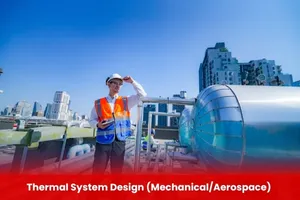Thermal System Design (Mechanical/Aerospace)
The Thermal System Design course by Burraq UK is designed for students and professionals in Mechanical and Aerospace Engineering who seek to deepen their understanding of heat transfer, energy systems, and thermal analysis in engineering applications.This course focuses on the design, simulation, and optimization of thermal systems used in a wide range of industries, including aerospace, automotive, energy, HVAC, and advanced manufacturing

Aim of Thermal System Design (Mechanical/Aerospace)
The aim of this course is to equip students and professionals with the theoretical knowledge and practical skills required to design, analyze, and optimize thermal systems used in mechanical and aerospace engineering applications.
Course Overview
Thermal System Design (Mechanical/Aerospace)
Total Modules 6
Training Credits 18
Directed Learning Hours (DLH) 90
Course Code BUK1394
- Educational Background
Applicants should have at least one of the following qualifications:
- Diploma (DAE) in:
- Mechanical Engineering
- Aerospace Engineering
- Thermal Power Technology
- HVAC or Energy Systems
- Bachelor’s Degree (BSc / BE / B.Tech) in:
- Mechanical Engineering
- Aerospace Engineering
- Mechatronics (with a thermal focus)
- Automotive or Energy Engineering
- Master’s Degree holders in relevant fields are welcome for advanced or project-based modules.
| Course Code | Curriculum Title | Credit | DLH |
|---|---|---|---|
| BUK1394-1 | Fundamentals of Thermodynamics | 3 | 15 |
| BUK1394-2 | Thermal System Components & Design | 3 | 15 |
| BUK1394-3 | Fluid Flow and Thermal Fluids | 3 | 15 |
| BUK1394-4 | Aerospace Thermal Applications | 3 | 15 |
| BUK1394-5 | Energy Efficiency and Optimization | 3 | 15 |
| BUK1394-6 | Energy Efficiency and Optimization | 3 | 15 |
Learning Objectives
- Fundamentals of Thermodynamics
- First and Second Laws of Thermodynamics
- Properties of gases and vapors
- Energy conservation principles
- Thermodynamic cycles (Rankine, Brayton, Otto)
- Heat Transfer Mechanisms
- Conduction: Fourier’s Law, thermal resistance networks
- Convection: Natural and forced convection, heat transfer coefficients
- Radiation: Stefan-Boltzmann law, blackbody radiation
- Combined heat transfer analysis
- Thermal System Components & Design
- Heat exchangers (shell & tube, plate, finned)
- Cooling and heating systems
- Insulation materials and thermal barriers
- Pumps, fans, and thermal fluid circulation
- Fluid Flow and Thermal Fluids
- Fluid properties and flow regimes
- Flow through pipes, ducts, and nozzles
- Pressure drop and flow losses
- Compressible vs incompressible flow (important for aerospace)
- Aerospace Thermal Applications
- Jet engine cooling and thermal protection
- Thermal insulation for aircraft structures
- Environmental control systems (ECS) in aircraft
- Avionics and electronics cooling systems
- Energy Efficiency and Optimization
- Heat recovery and energy reuse
- Exergy analysis
- System performance optimization
- Sustainable design considerations
- Thermal System Simulation Tools
- Introduction to thermal simulation software:
- ANSYS Fluent / CFX
- SolidWorks Flow Simulation
- COMSOL Multiphysics
- Case studies using simulation
- Design Projects & Case Studies
- Real-world design problem solving
- Project: Design of a cooling system for an aerospace component
- Industry-based case studies
- Report writing and technical documentation
- Engineering Students
- Engineering Graduates
- Working Professionals
- Technicians & CAD Designers
- Career Switchers
- All Modules within this qualification are assessed internally by the approved training Centre and externally verified by BURRAQ UK. The program uses a criterion-referenced assessment approach to ensure that learners successfully meet all required learning outcomes.
- A Pass in any unit is granted only when the learner submits valid, reliable, and authentic evidence that demonstrates achievement of the assessment criteria. The Assessor is responsible for reviewing this evidence and confirming that the learner has attained the expected standard.
